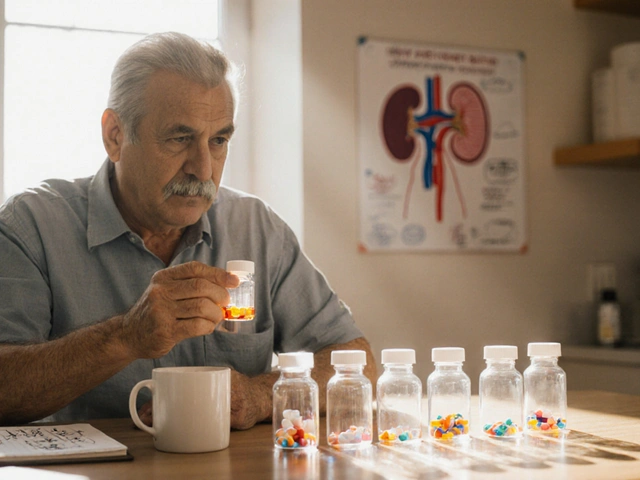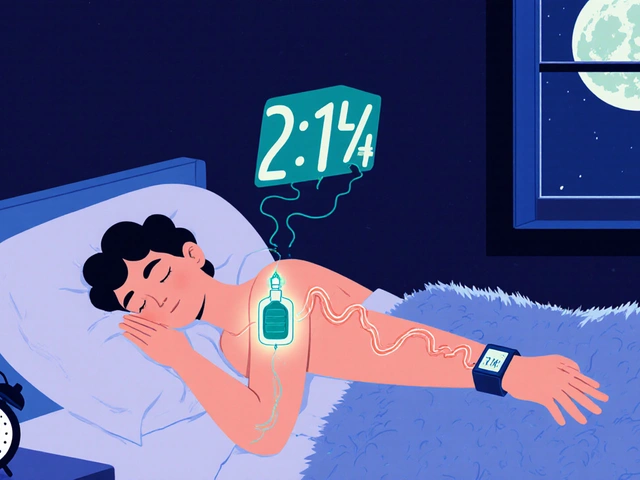Ever wonder how that little tablet of irbesartan became a staple in treating high blood pressure and kidney issues? It's not just about popping a pill; it's a fascinating journey through history and science. Let's start at the beginning.
Back in the day, before irbesartan came along, the options for managing hypertension weren't as effective or targeted. Scientists and researchers saw the need for something better, leading to the development of a group of drugs called angiotensin II receptor blockers (ARBs), with irbesartan being a standout star.
Irbesartan works by blocking certain chemical actions that tighten blood vessels. This explains why it's so effective in keeping high blood pressure at bay and helping kidneys function optimally, especially in people with type 2 diabetes. It's like giving your heart and kidneys a little bit of extra cushion and support.
- The Early Days of Irbesartan
- Scientific Advancements and Innovations
- Irbesartan's Impact on Hypertension
- Kidney Health and Irbesartan
- Future Prospects and Developments
The Early Days of Irbesartan
The story of Irbesartan starts in the late 20th century. Researchers were desperately searching for better ways to manage high blood pressure. Back then, the options were pretty limited, and not everyone responded well to the existing drugs.
Enter the concept of Angiotensin II Receptor Blockers (ARBs), a novel class of drugs to address this very issue. Scientists figured out that by blocking Angiotensin II—a chemical in the body that causes blood vessels to tighten—they could keep blood pressure more stable. This marked a significant shift in the treatment strategy.
Breaking Ground with ARBs
Throughout the late 1980s and early 1990s, various pharmaceutical companies invested heavily in discovering and developing these ARBs. It became a bit of a race in the medical community, with everyone aiming to create the most effective ARB possible.
Irbesartan, developed by Sanofi in collaboration with Bristol-Myers Squibb, emerged against this backdrop of intense research and competition. Unlike some other medications, it offered a unique binding affinity, setting a promising stage for more selective action in the body.
FDA Approval and Initial Uses
By the time 1997 rolled around, the puzzle pieces finally fell into place. The U.S. Food and Drug Administration (FDA) approved Irbesartan for medical use. This approval marked a crucial milestone, underlining the scientific reliability and potential of the drug.
In its infancy, Irbesartan was predominantly utilized for controlling hypertension and protecting kidneys in patients with type 2 diabetes. Practitioners soon began recognizing its broader benefits, catalyzing its rapid adoption in treatment protocols worldwide.
Fast forward a couple of decades, and Irbesartan is globally recognized and trusted, a testimony to the persistence and innovation that characterized its early development years.
Scientific Advancements and Innovations
When it comes to irbesartan, a lot of scientific brainpower went into getting it just right. Back in the 1980s, the race was on to find a new class of drugs that could tackle high blood pressure more effectively. Scientists knew about the role of angiotensin II, a hormone that constricts blood vessels, making it the perfect target. It was like finding the Achilles' heel of hypertension.
Researchers focused on creating a compound that could block the effects of this hormone without causing too many side effects. Fast forward a bit, and we have ARBs, with irbesartan being one of the top-performing players. One of the cool things about irbesartan is that it's selectively specific. This means it targets precisely the receptor that angiotensin II binds to, leading to fewer unwanted effects.
Innovative Research Techniques
The development of irbesartan wasn't just guesswork. Scientists utilized high-tech methods, like computer-aided drug design, to predict how different chemical compounds would interact with the human body. Imagine having a virtual sandbox to test out how a new drug might work before it's even made. This type of innovation was crucial.
Once they had a promising candidate, testing moved to the lab. Here, a combination of clinical trials and pharmacological studies confirmed its efficacy and safety. It wasn't just about proving it worked; they needed to ensure it was better than existing treatments and safe for long-term use.
Living up to Expectations
After FDA approval, irbesartan hit the market in the late 1990s and quickly became popular for its ability to lower blood pressure effectively. What really set it apart was how well it worked for people with kidney issues, especially diabetic nephropathy. This was a game-changer since it meant one less worry for patients managing both diabetes and kidney health.
Thanks to these scientific advancements, irbesartan has remarkably sustained its place in medicine. It's a textbook example of how detailed research and innovation can lead to big wins in healthcare.

Irbesartan's Impact on Hypertension
When it comes to tackling high blood pressure, few medications have made as big a splash as irbesartan. This drug has carved a niche for itself by offering a reliable option for those wrestling with hypertension. But just how does it make a difference?
First off, irbesartan shines in its ability to lower blood pressure in a way that's both effective and gentle on the body. This matters because keeping your blood pressure in check reduces the risk of serious conditions like heart attack and stroke, the big bad wolves of cardiovascular health.
How It Works
The magic behind irbesartan lies in its role as an angiotensin II receptor blocker (ARB). By blocking the effects of angiotensin II—a hormone that narrows blood vessels—it keeps the vessels open and relaxed, allowing for smoother blood flow. It's a little like unclogging a traffic jam, letting cars (or in this case, blood) flow freely.
In terms of numbers, those taking irbesartan often see a significant drop in their blood pressure levels, leading to better overall health outcomes. Some studies suggest reductions are quite notable, particularly in those with severe hypertension.
Key Benefits
- Lowers Blood Pressure: It's most known for reducing those numbers on the dial.
- Protects Heart Health: By managing blood pressure, it indirectly supports heart functioning.
- Enhances Kidney Function: Especially in diabetic patients, it helps protect against kidney damage.
There's also a convenience factor. Unlike some medications that require a complex regimen, irbesartan is usually taken once daily, making it easier to incorporate into daily routines.
| Impact | Result |
|---|---|
| Lower Blood Pressure | Significant Reduction |
| Heart Health | Improvement |
| Kidney Protection | Notable Benefits |
So, if you're one of the millions dealing with high blood pressure, irbesartan might just be the ally you've been looking for. It's proof that effective hypertension management is within reach, thanks to a little tablet that's packed with potential.
Kidney Health and Irbesartan
Irbesartan isn’t just about controlling blood pressure; it plays an incredible role in maintaining kidney health, particularly for folks with type 2 diabetes. Keeping kidneys in tip-top shape is crucial, and Irbesartan helps by reducing the pressure inside these vital organs.
Managing diabetic nephropathy, a type of kidney damage resulting from diabetes, is one of the primary uses for Irbesartan. By relaxing blood vessels, it lightens the load on kidneys, potentially slowing or even stopping further damage. According to the American Diabetes Association, “Blood pressure control is crucial in slowing the progression of kidney disease,” a principle Irbesartan effectively supports.
“In diabetic kidney disease, treatment with an angiotensin receptor blocker significantly lowered the rate of progression to end-stage renal disease,” — The New England Journal of Medicine.
Benefits of Irbesartan for Kidneys
- Lowers elevated blood pressure, guarding against further kidney damage.
- Reduces proteinuria, which is excess protein in the urine—a key indicator of kidney problems.
- Improves overall kidney function when used over the long term.
The impact of Irbesartan on kidney health isn't just theoretical. Real-world evidence shows it helps many people lead healthier lives. Studies found that patients using this medication had a lower risk of progressing to more severe stages of kidney disease.
Considerations and Monitoring
Like any medication, it's important to use Irbesartan under a doctor's guidance. Regular monitoring of kidney function and blood pressure is key for those taking this treatment. Healthcare providers often adjust doses based on how well your body responds.
Keeping an eye on symptoms and routine checks can prevent complications down the line. Always discuss any concerns with a healthcare provider to ensure the treatment is effective for your needs.

Future Prospects and Developments
Thinking about what lies ahead for irbesartan is pretty exciting, especially given how far it's come already. Researchers are constantly on the lookout for ways to improve and expand its uses.
One promising area is combining irbesartan with other medications to enhance its efficacy. This approach could benefit patients who haven't had a strong response to single-drug therapies. Imagine if a dual-pill regimen could manage more stubborn cases of hypertension or better protect kidney health!
An innovative focus in the pharmaceutical world is on personalizing medicine. Scientists are keen on figuring out which patients benefit most from irbesartan. This game plan involves looking at genetic markers to predict how someone will respond to the drug. It’s like crafting a tailor-made suit - but for your health!
The development of newer formulations might also change the game. Think long-acting dosages that patients take less frequently, improving adherence and convenience. Convenience can make a big difference in people sticking to their health regimes.
Some intriguing studies are looking at irbesartan's potential beyond current uses. Who knows? It might even play a role in tackling other cardiovascular diseases or metabolic disorders, but more evidence is needed before casting any predictions.
Irbesartan isn't just sitting still; its journey is far from over. With so much interest from the scientific community, patients and healthcare providers can expect exciting developments down the road. Medication isn't the only part of health, but with advances like these, it surely can tip the scales towards better well-being.








6 comments
Amelia Wigton
Irbesartan's selective AT1 receptor antagonism is a pharmacological triumph-its high affinity for the angiotensin II receptor subtype, coupled with minimal cross-reactivity with other G-protein-coupled receptors, translates to a superior side effect profile compared to earlier ACE inhibitors, particularly in reducing cough incidence and angioedema risk. The pharmacokinetics are notably linear, with dose-proportional AUC and a half-life exceeding 11 hours, enabling once-daily dosing without significant fluctuations in BP control. Moreover, its lack of active metabolites simplifies therapeutic monitoring and reduces drug-drug interaction potential, especially in polypharmacy scenarios common among elderly hypertensive populations with comorbidities.
Shubham Singh
People act like this drug is some miracle cure, but let's be real-pharma companies push these things because they make money, not because they're perfect. I've seen patients on irbesartan get dizzy, dehydrated, and end up in the ER because no one told them to watch their potassium. And don't get me started on how they ignore the fact that lifestyle changes should come first. This isn't science-it's corporate profit dressed up in white coats.
Hollis Hamon
It's interesting how irbesartan became such a cornerstone without being flashy. I remember when I first started seeing it prescribed-no big marketing blitz, no viral TikTok videos. Just quiet, consistent results in patients who needed it. It doesn't fix everything, but it gives people stability. That's more than a lot of newer drugs can say. I think we underestimate the value of drugs that just... work, without drama.
Adam Walter
Irbesartan isn't just a pill-it's a quiet revolution in renal protection. Picture this: a diabetic kidney slowly drowning in proteinuria, its glomeruli screaming under pressure. Then-irbesartan, the gentle giant, steps in. It doesn't just lower BP; it silences the renin-angiotensin cascade like a master key turning in a rusted lock. The drop in urinary albumin? That's not a number-it's a lifeline. And let's not forget the elegance of its molecular structure: that biphenyl tetrazole moiety? Pure medicinal chemistry poetry. It binds like a velvet glove on a steel fist-precise, powerful, and patient. This isn't just pharmacology. It's art with a prescription pad.
Gurupriya Dutta
I’ve had a few patients on irbesartan who were skeptical at first, but once they saw their protein levels drop and their creatinine stabilize, they were amazed. It’s not flashy, but it’s dependable. I appreciate how it works gently over time rather than forcing changes. It’s the kind of medication that reminds me why I went into medicine-to help people feel steady, not just treated.
Michael Lynch
Kinda makes you think-most of us just take pills without knowing the story behind them. Irbesartan didn’t just appear. It was built by years of trial, error, and quiet persistence. Sometimes the most important things aren’t the loudest. Just a small molecule, doing its job, keeping hearts beating and kidneys filtering. Simple, really. But beautiful in its simplicity.